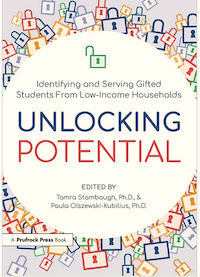Serving Gifted Students from Low-Income Homes
Unlocking Potential: Identifying and Serving Gifted Students from Low-Income Households
Edited by Tamra Stambaugh, Ph.D., and Paula Olszewski-Kubilius, Ph.D.
(Routledge/Prufrock Press, 2020 – Learn more)
Reviewed by Kim Rensch

Their book, Unlocking Potential: Identifying and Serving Gifted Students from Low-Income Households, is a collection of essays that turn research into actionable practices. It is a must-read for all educators of gifted students.
The Reading Experience

Subsequent chapters delve more deeply into these recommendations, covering such important topics as identification of students for gifted programs, curriculum development, instructional strategies, and supporting students and families inside and outside of school.
The editors themselves close out the book with their chapter called “Voice and Reflections,” where they save the final word for “several individuals who grew up in low-income households and are at various stages in their career development” (310). Stambaugh and Olszewski-Kubilius capture their responses in seven themes, giving educators a pathway for developing systems of identifying and serving gifted students who come from low-income households.
Despite this organization, Unlocking Potential does not have to be read from front cover to back cover. Time-strapped educators could choose a chapter that meets their immediate needs and dive into the 20 or 30 pages typical of most of the chapters in this book.
Helpful Features
While the entire book offers a treasure trove of information and guidance for developing systems that work for students living in low-income situations, certain features stand out as especially useful. Practitioners seeking sample learning activities will find them in the middle of the book in two chapters covering instructional strategies, separated into the humanities and the STEM fields.
Gifted programming coordinators and district administrators will especially appreciate the “Implementation Checklists for Coordinators Using a Systems Approach to Find and Nurture Gifted Potential in Low-Income Learners” presented as an appendix to chapter 12, which acts as an evaluation tool to measure a gifted education program’s strengths and weaknesses.
A potentially overlooked feature of this book is the presence of a reference list at the end of each chapter. Readers desiring to dive more deeply into a topic will find no shortage of resources, as each chapter’s works cited section is rather lengthy (hello, chapter three and your 10 pages of resources!). The authors of each chapter truly left no resources unchecked in their pursuit of accuracy and relevance.
A Note About the Intended Audience
While the audience for this book is clearly those who work with gifted students, there is no doubt that the authors present strategies and wisdom that will serve ALL students well, regardless of socioeconomic status or intellectual capacity. Learning experiences that integrate literacy, focus on vocabulary development, promote relevance, or “[target] development of particular skills while ensuring high levels of challenge and growth” (151) are learning experiences that any student deserves.
A Final Note
Sometimes when I read a teaching-related book, I take away some ideas, shelve the book, and forget about it. Unlocking Potential is not a book that will gather dust. There is simply too much at stake for students living in poverty to ignore these authors’ wisdom and research. This will be a resource that shapes our gifted education program a long time into the future
Kim Rensch (@KJRensch) is a National Board Certified Teacher working as a member of the Gifted Services team for Fargo Public Schools in North Dakota. She is a Teacher-Consultant in the Red River Valley Writing Project and a board member of the North Dakota Association for Gifted Children. When she’s not doing something school-related, Kim can be found spending time with her husband and their dogs, or with her many plants and flowers.






























Serving gifted students from low-income homes requires a thoughtful and inclusive approach to ensure these students receive the support and opportunities they deserve.